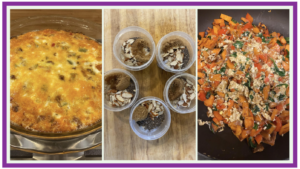Pre and Probiotics: The Dynamic Duo
We’ve all heard the phrase “follow your gut.” But what if your gut is giving you confusing signals? For those with frequent constipation, diarrhea, nausea, gas, bloating and other uncomfortable stomach issues, this can be the case. One way to understand what your body is trying to tell you is to take a quick inventory of the things that we know help you feel your best. Fortunately, there are unique nutrients in foods called prebiotics and probiotics that can actually help manage these symptoms (and many others) and maybe even help ease troubles down the road.
What are Pre and Probiotics:
Probiotics are found in foods and supplements with live microorganisms that help to maintain and increase the number of “good” bacteria in the gut.
On the other hand, prebiotics are nutrients found in foods (and more recently in supplements) that help to feed and balance the gut microflora, or the “good” bacteria, mentioned above.
Prebiotics and probiotics work synergistically, or together in harmony, to build and support a healthy gut-microbiome.
Why are Pre and Probiotics Important:
When we eat pre and probiotics, our gut then has the tools to be able to:
- Digest or break down the foods we eat, which may help to manage or reduce unpleasant gut symptoms
- Control inflammation by helping the body to absorb and use nutrients effectively and efficiently
- Communicate with a variety of cells in the body that impact the immune system, brain function, and even mood regulation
Foods with Prebiotics:
Think high-fiber foods like …
- Artichokes
- Asparagus
- Bananas
- Whole grains
- Beans
- Onions, garlic, and leeks
Foods with Probiotics:
Think fermented or cultured foods like…
- Yogurt
- Kefir
- Sauerkraut
- Kimchi
- Aged cheeses
Supplements:
When considering the right pre or probiotic for you, there are several factors to consider. First and foremost, because supplements are not regulated in the U.S., talking to your doctor or provider about the specific product you are thinking about taking is always recommended. Second, not all products are the same. There are a variety of beneficial bacteria such as Lactobacillus and Bifidobacterium to name a few, and many contain additional nutrients or enzymes that may also impact function and tolerance. Unfortunately, this means some may work for you and your condition and some may work against it. This is where your healthcare team comes into play! Lastly, it is important to think about how much and how often you plan to supplement. This is to make sure you are getting all the good stuff without the potential negative side effects like additional GI discomfort and of course, loss of time and money.
The Bottom-Line
When it comes to how you feel, even a small amount of discomfort can have an impact on your day, not to mention your food choices. Getting to the root-cause as soon as possible is key. While good nutrition is essential, it is also important to consider other factors that impact gut health like daily movement, stress management, sleep habits, and even medications such as antibiotics. Keep the conversation going with your healthcare team for tools and resources and make sure to communicate concerns you have as soon as possible. The best thing we can do for ourselves is to be proactive . . . and what better way to do that than with delicious food!
AS



